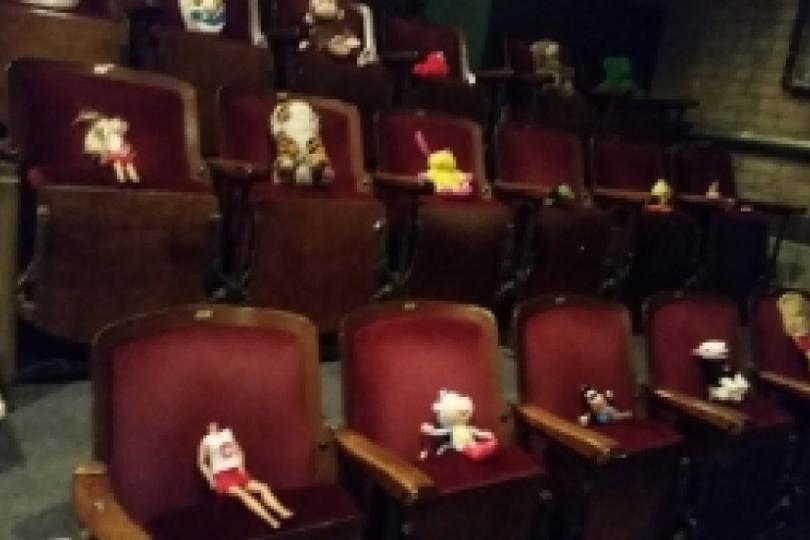REVIEW: What is a Horror Festival?
Review

Until last year’s Twin Cities Horror Festival, I thought the biggest dividing line between cinematic and theatrical horror was that movies have the luxury of couching their scares in high-end special effects and creative editing. After watching the blood-soaked glory of RawRedMeat Productions’ Hear No Evil at TCHF II, I realized that the gory gulf between stage and screen isn’t quite as wide as I had thought.
But production values and visual panache like RawRedMeat’s are a rarity even in the realm of onstage horror. Most theatrical horror has to come by its scares in more muted fashion. In my attempt to review at least two-thirds of the entries in this year’s Horror Festival, I figured it might be useful to separate the shows that traffic in physical shock and those that keep things relatively bloodless.
Before I get started, let’s reflect for a moment on how amazing it is that we have an annual theater showcase dedicated to horror. That’s another one of those colossal art things that just doesn’t exist in most urban centers. For the uninitiated, it probably bears explaining that the Twin Cities Horror Festival is maybe a bit of a misnomer, inasmuch as audiences shouldn’t go in expecting wall-to-wall scares. A good number of the production companies involved deal primarily in comedy, and there’s dance and live music in the mix as well. Horror is the unifying theme, to be sure, but only a few of each year’s pieces qualify as capital-H Horror Theater. The festival is more an exploration of the things that scare us and the many faces of fear. It’s something like a mini-Fringe built around a common core.
Erin Sheppard Presents’ Dance with the Devil is a good case in point. Anybody who’d come away from this mashup of dance and monologues on the Seven Deadly Sins genuinely frightened would probably be too creeped out by the faux-distressed columns of the Southern stage to make it through the show. That’s no knock against Dance with the Devil, which is more about unsettling than scaring.
Most of the dance segments involve a dancer making a deal with the devil (Rhett Romsaas in a neatly trimmed beard and Miami Vice suit) in exchange for fame, love, etc. Watching the performers’ expressions of ecstasy give way to panic once the bargains inevitably begin to fall apart is the highlight of the dance program, especially Sheppard’s palpable, fluid terror as she’s beset on all sides by faceless sin-monsters. I should also mention “Cerberus,” a stand-alone piece that briefly abandons the devil and his deals and allows three dancers to immerse themselves in the horror movie bravado of Kanye West’s “Monster.” Nicki Minaj’s verse on that track is one of my favorite things in recent hip-hop history, and it turns out a trio of dancers bring her climactic roar to life is something I’ve been yearning to see without ever knowing it.
The other half of Dance with the Devil is a series of monologues by Rita Boersma about her relationships with a variety of sins. Most of these stories touch only vaguely on horror – Boersma getting cornered at a Rochester gas station by a woman who believes her to be a tool of the devil is about as scary as it gets – but she’s such a charming and self-effacing storyteller that it doesn’t matter. The dance and the spoken word work wonderfully on their own but don’t always mesh quite as smoothly as might be hoped. That just winds up illustrating one of the unspoken themes of the festival: the uneasy give-and-take between horror and humor.
That balance is even more starkly illustrated in Farmhouse by The Importance of Being Fotis, a production that for the most part keeps its horror elements simmering so subtly in the background that their eventual emergence would come as a complete shock were it not part of this festival. For most of its running time, Farmhouse plays as a tense dark comedy about two sisters and a nervous husband snowed into a remote farmhouse immediately following the funeral of the women’s father. Driven by Mike Fotis’s biting dialogue and the nicely acerbic interplay between Debra Berger and Katie Vannelli’s resentful sisters, it’s a good bit of grim fun, but the submersion of the horror aspects got me to wondering.
Watching Farmhouse in a room full of people who came out to the Horror Festival expressly primed for a scary theater experience put a different spin on the production than it might have had in another context. The Horror Festival masthead lends more meaning to plot points like the unseen but oft-mentioned coffin in the dining room or a long-ago feud with a hot-headed neighbor. The audience knows something scary is going to develop out of all of this, which both intensifies the waiting and makes the payoff feel somewhat inevitable. Would the show work as well in another venue? Would a lack of festival expectations improve the experience, or would it make the horror elements feel perfunctory? These questions are academic at best, but it’s worthwhile to ponder how much of a genre festival’s impact is self-sustaining.
There are no such questions about Four Humors’ Doll Collection, an assemblage of short plays and interludes that falls firmly in the horror camp. Its multi-angled handling of the inherent creepiness of dolls is reminiscent of the venerable subgenre of horror anthology films like The Uncanny, Grim Prairie Tales or V/H/S, movies that weave a tapestry of short stories around a common theme. On film those projects are notoriously uneven, but Doll Collection manages an impressive hit-to-miss ratio.
Past productions like Lolita and The Murderer Did It! have earned Four Humors a reputation for observing and subverting storytelling tropes of all kinds, and that talent is on full display here. The stories in Doll Collection range from old-school spookiness (an island is haunted by the doll-obsessed ghost of a little girl) to broad comedy (a loner's sex doll purchase quickly spirals out of control) to Twilight Zone-esque head trips (a genius doll-maker begins to lose the thread of reality during a newspaper interview).
Even the scene transitions are thrillingly creepy, ushered in by Katie Kaufmann as a living babydoll whose fourth-wall invasions seem to terrify the other characters as she shepherds them to yet another existence. Everything here fits the festival to a tee, and a lot of it is marvelously funny to boot. Perhaps Doll Collection doesn't dig quite as deeply into the inner workings of narrative as have some of Four Humors' previous productions, but it's a show that knows its voice through and through, even as that voice keeps changing.
Tune in Thursday for an examination of some of TCHF's more sadistic offerings.




